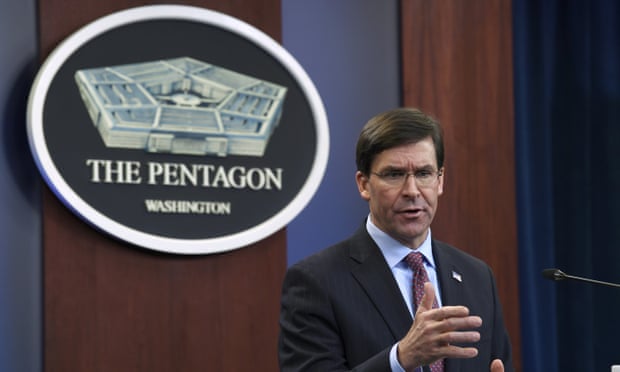The Pentagon has briefed about the simulated exchange in a move that could signal readiness to fight and win nuclear conflict
The US conducted a military exercise last week which simulated a “limited” nuclear exchange with Russia, a senior Pentagon official has confirmed.
The war game is notable because of the defence department’s highly unusual decision to brief journalists about the details and because it embodied the controversial notion that it might be possible to fight, and win, a battle with nuclear weapons, without the exchange leading to an all-out world-ending conflict.
The exercise comes just weeks after the US deployed a new low-yield submarine-launched warhead commissioned by Donald Trump, as a counter to Russian tactical weapons and intended to deter their use.
According to a transcript of a background briefing by senior Pentagon officials, the defence secretary, Mark Esper, took part in what was described as a “mini-exercise” at US Strategic Command in Nebraska. Esper played himself in the simulated crisis, in which Russia launched an attack on a US target in Europe.
“The scenario included a European contingency where you are conducting a war with Russia, and Russia decides to use a low-yield limited nuclear weapon against a site on Nato territory,” a senior official said. “And then you go through the conversation that you would have with the secretary of defense and then with the president, ultimately, to decide how to respond.”
The official said that “in the course of [the] exercise, we simulated responding with a nuclear weapon”, but described it as a “limited response”.
The limited response could suggest the use of a small number of nuclear weapons, or an existing low-yield weapon, or the new W76-2 low-yield submarine-launched missile which was deployed in the Atlantic for the first time at the end of last year. The deployment only became public at the end of January.
At the same time as describing last week’s war game, Pentagon officials defended the fielding of the W76-2.
“It’s a very reasonable response to what we saw was a Russian nuclear doctrine and nuclear capability that suggested to us that they might use nuclear weapons in a limited way,” a senior official said.
The briefing was first reported by National Defense, a trade magazine of the National Defense Industrial Association.
Hans Kristensen, the director of the nuclear information project at the Federation of American Scientists, pointed out that it was extremely rare for the Pentagon to give such detailed briefings about nuclear exercises and suggested it could have been a marketing exercise for the new weapons being added to the US arsenal.
“Remember, it’s only a few weeks ago that we had the official confirmation that this new low-yield warhead had been deployed,” Kristensen said. “And we’re now moving into a new budget phase where they have to go to Congress and try to justify the next new nuclear weapon that has a low-yield capability which is a sea-launched cruise missile. So all of this has been played up to serve that process.”
Advocates of the new US weapons say they represent a deterrent against Moscow believing it can use a tactical nuclear weapon without a US response, as Washington would have to choose between not responding, or dramatically escalating through the use of a much more powerful strategic nuclear warhead.
Arms control advocates are concerned that the leadership in both the US and Russia are developing a mindset in which their vast nuclear arsenals are not just the ultimate deterrent but weapons that could be used to win “limited” conflicts.

